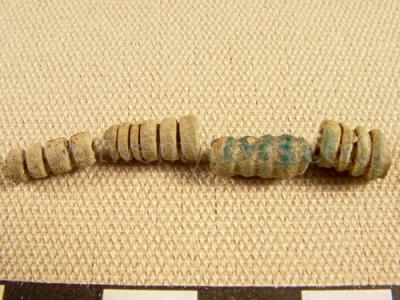Europe, British Isles, South-West England, Wiltshire, Stonehenge Landscape, Stonehenge Barrows, Winterborne Stoke Barrows, Winterbourne Stoke West Barrows
Winterbourne Stoke West Barrows is in Winterborne Stoke Barrows.
Europe, British Isles, South-West England, Wiltshire, Stonehenge Landscape, Stonehenge Barrows, Winterborne Stoke Barrows, Winterbourne Stoke West Barrows, Winterbourne Stoke West Barrow 1 G61 [Map]![]()
Colt Hoare 1812. No. 1 [Map] is a large and wide Druid barrow, in which it appeared that the primary interment had been moved to make room for the subsequent deposit of a skeleton, which also had been disturbed at some still later period. In examining the cist which contained the skeleton, we observed that the feet had not been displaced; near them was an iron knife; and in our further researches we found at the bottom of the cist several fragments of burned bones, belonging to the remains of the original interment.
Europe, British Isles, South-West England, Wiltshire, Stonehenge Landscape, Stonehenge Barrows, Winterborne Stoke Barrows, Winterbourne Stoke West Barrows, Winterbourne Stoke West Barrow 2 G62 [Map]![]()
Colt Hoare 1812. No. 2 [Map], like many of the others in this group, is much mutilated, and of large diameter, but not more four feet in elevation. It contained an interment of burned bones secured within a very large brown urn rudely ornamented, which was broken by taking out. A considerable quantity of linen cloth was perceptible among the bones.
Europe, British Isles, South-West England, Wiltshire, Stonehenge Landscape, Stonehenge Barrows, Winterborne Stoke Barrows, Winterbourne Stoke West Barrows, Winterbourne Stoke West Barrow 3 G63 [Map]![]()
Colt Hoare 1812. No. 3 [Map], a flat barrow, mutilated, and about the same elevation as the last, contained within an oval cist, a simple interment of burned bones, and shreds of linen cloth.
Europe, British Isles, South-West England, Wiltshire, Stonehenge Landscape, Stonehenge Barrows, Winterborne Stoke Barrows, Winterbourne Stoke West Barrows, Winterbourne Stoke West Barrow 4 G63a [Map]![]()
Colt Hoare 1812. No. 4 [Map] afforded no sepulchral remains, and probably was not intended for a barrow.
Europe, British Isles, South-West England, Wiltshire, Stonehenge Landscape, Stonehenge Barrows, Winterborne Stoke Barrows, Winterbourne Stoke West Barrows, Winterbourne Stoke West Barrow 5 G64a [Map]![]()
Colt Hoare 1812. No. 5 [Map], a circular flat barrow, contained a double cist; the smallest of which produced a little dagger of brass, and a variety of beads, amongst which were two joints of the vertebral column of a petrified encrinus. The beads, in number about four dozen, were neatly made of clay, but not well burned, except two of the largest, which had been ornamented with faint striæ. Besides the above were a great quantity of curious little shells, in shape like the Hirlas horn used by the Britons, which were perforated lengthways, and formed probably the necklace of some female. (Tumuli Plate XIII.) The large cist contained only the bones of a sheep.
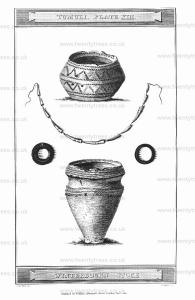
Wiltshire Museum. DZSWS:STHEAD.67. 3 beads made from sectioning a fossil encrinite stem (or sea lily) found in a primary deposit (no inhumation) in (confluent) bowl barrow Winterbourne Stoke G64a [Map] (i), excavated by William Cunnington.

Wiltshire Museum. DZSWS:STHEAD.68. 18 clay beads (48 originally discovered) found in a primary deposit (no inhumation) in (confluent) bowl barrow Winterbourne Stoke G64a [Map] (i), excavated by William Cunnington.

Wiltshire Museum. DZSWS:STHEAD.69. 22 fossil dentalium beads found in a primary deposit (no inhumation) in (confluent) bowl barrow Winterbourne Stoke G64a [Map] (i), excavated by William Cunnington.

Europe, British Isles, South-West England, Wiltshire, Stonehenge Landscape, Stonehenge Barrows, Winterborne Stoke Barrows, Winterbourne Stoke West Barrows, Winterbourne Stoke West Barrow 6 G64b [Map]![]()
Colt Hoare 1812. No. 6 [Map] is a flat circular barrow, in which we found an oval cists containing burned bones, and a rude little cup, resembling a saucer, which was broken.
Wiltshire Museum. DZSWS:STHEAD.69a. 1 saucer-shaped incense cup (broken) decorated with three lines of impressed cord around its with broad flat rim, found with a primary cremation in Bowl barrow Winterbourne Stoke G64b [Map], excavated by William Cunnington.
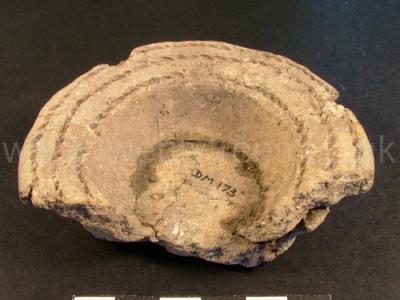
Europe, British Isles, South-West England, Wiltshire, Stonehenge Landscape, Stonehenge Barrows, Winterborne Stoke Barrows, Winterbourne Stoke West Barrows, Winterbourne Stoke West Barrow 7 G64 [Map]![]()
Colt Hoare 1812. No. 7 [Map] is a small pond barrow.
Europe, British Isles, South-West England, Wiltshire, Stonehenge Landscape, Stonehenge Barrows, Winterborne Stoke Barrows, Winterbourne Stoke West Barrows, Winterbourne Stoke West Barrow 8 G66 [Map]![]()
Colt Hoare 1812. No. 8 [Map], a very irregular flat barrow, three feet high, produced near the centre a large urn standing upright within a circular cist, and containing, amongst an interment of burned bones, a small brass dagger, with a bone top to it, neatly finished, with five holes on the side for so many rivets, by which it was fastened a wooden handle. The urn found in this tumulus was very large, and elegantly formed; (Tumuli Plate XIII.) it contained a few black beads that had undergone the action of fire, and was so closely cemented to the chalk, that we had great difficulty in detaching it from the cist.

Wiltshire Museum. DZSWS:STHEAD.86. 1 bronze knife dagger with 3 rivet holes and one rivet remaining (broken in three places) found with a primary cremation (in an upright food vessel) in bowl barrow Winterbourne Stoke G66 [Map], excavated by William Cunnington.

Wiltshire Museum. DZSWS:STHEAD.86a. 1 bone pommel with 5 rivet holes in both sides and two in the end found with a primary cremation (in an upright food vessel) in bowl barrow Winterbourne Stoke G66 [Map], excavated by William Cunnington.

Europe, British Isles, South-West England, Wiltshire, Stonehenge Landscape, Stonehenge Barrows, Winterborne Stoke Barrows, Winterbourne Stoke West Barrows, Winterbourne Stoke West Barrow 9 G65 [Map]![]()
Colt Hoare 1812. No. 9 [Map], a flat circular barrow, contained two small round cists, in each of which was deposited an interment of burncd bones; in one we found curious little double cup;1 in the other, no articles whatever.
Note 1. This cup has a division in the middle, which renders the hollow on each side equal it is unlike in this particular any we have yet found, and is very neatly ornamented in the usual rude style, with the Vandyke pattern. An engraving of it, full size, is given in Tumuli Plate XIII.

Wiltshire Museum. DZSWS:STHEAD.71. 1 reversible incense cup, with its inside base at waist height allowing it to be used upside down, decorated with impressed cord in two bands of zigzags with two parallel lines either side of each and one around the inside rim (also perforated four times for suspension) found with a primary cremation in Bowl barrow Winterbourne Stoke G65 [Map], excavated by William Cunnington.

Europe, British Isles, South-West England, Wiltshire, Stonehenge Landscape, Stonehenge Barrows, Winterborne Stoke Barrows, Winterbourne Stoke West Barrows, Winterbourne Stoke West Barrow 10 G67 [Map]![]()
Colt Hoare 1812. No. 10 [Map] was opened by Mr. Cunnington in the year 1804. In its form, it resembles the second class of Druid Barrows, is neatly ditched round, having the vallum without, and the tumulus rising gradually to its apex from the ditch. It contained an urn inverted over the burned bones, which had been wrapped up in a linen cloth, to protect them; and with the bones were found a small brass pin, employed probably for fastening the cloth, five rings of a dark brown colour, one of which was perforated for suspension, (Tumuli Plate XIII.) a small cone of the same materials perforated also for the same purpose, and several pully beads of glass, with one of jet, and another of amber.

Wiltshire Museum. DZSWS:STHEAD.70. 5 rings of Kimmeridge shale (one of which was perforated for suspension) found with a wrapped primary cremation under an inverted urn in disc barrow Winterbourne Stoke G67 [Map], excavated by William Cunnington.
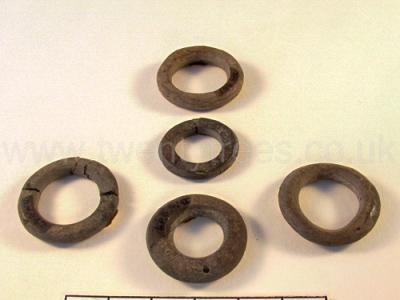
Wiltshire Museum. DZSWS:STHEAD.70a. 1 conical button of Kimmerage shale (v-bored on base) found with a wrapped primary cremation under an inverted urn in disc barrow Winterbourne Stoke G67 [Map], excavated by William Cunnington.
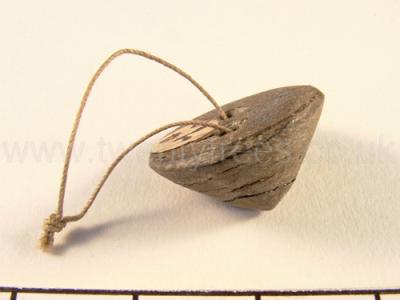
Wiltshire Museum. DZSWS:STHEAD.70c. 1 spherical amber bead found with a wrapped primary cremation under an inverted urn in disc barrow Winterbourne Stoke G67 [Map], excavated by William Cunnington.

Wiltshire Museum. DZSWS:STHEAD.70e. 3 segmented faience beads (2 four segment & 1 three segment bead) found with a wrapped primary cremation under an inverted urn in disc barrow Winterbourne Stoke G67 [Map], excavated by William Cunnington.
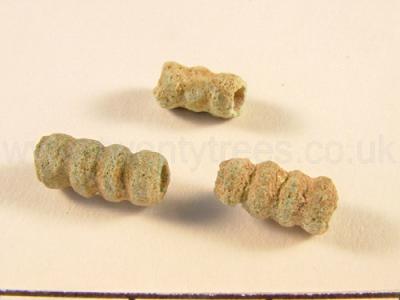
Europe, British Isles, South-West England, Wiltshire, Stonehenge Landscape, Stonehenge Barrows, Winterborne Stoke Barrows, Winterbourne Stoke West Barrows, Winterbourne Stoke West Barrow 11 G69 [Map]![]()
Colt Hoare 1812. No. 11 [Map]. This barrow, more perfect in its external form than the rest, contained within an oblong cist, a simple interment of burned bones.
Europe, British Isles, South-West England, Wiltshire, Stonehenge Landscape, Stonehenge Barrows, Winterborne Stoke Barrows, Winterbourne Stoke West Barrows, Winterbourne Stoke West Barrow 12 G68 [Map]![]()
Colt Hoare 1812. No. 12 [Map]. The vallum of this large Druid barrow is so much defaced, and the elevation of the mound so very trifling, that it might easily escape general notice. It contained a very large rude urn, sixteen inches and a half deep, inverted over an interment of burned bones, and within it a smaller vase. With them were found two black rings similar to those before described, but not perforated for suspension, large amber bead perforated, four pully beads, and three of a black colour. The three last mentioned barrows are situated on the outside of the bank and ditch, which, at first sight, bear an equivocal appearance from their singular shape, resembling a pentagon, which I have before, stated as being a favourite form with the Britons; but on a close investigation of them, they appear decidedly of a more modern date than the barrows. The name of the hill, Conigar, and the vulgar tradition of this spot having once been appropriated to a rabbit-warren, will corroborate this conjecture, and ascertain the origin of this earthen enclosure. On the adjoining hill, called High Down, and to the N. W. of the group of barrows, are the decided remains of a British village, in which we found coins of the Lower Empire, pottery of various sorts, with animal bones, and all the usual indicia of an ancient British and Roman population.
Wiltshire Museum. DZSWS:STHEAD.70b. 1 rough bowl-shaped incense cup decorated with irregular squares of impressed dots around one side and smaller squares, crosses and other shapes around the other (the thick rim also has lines of impressed dots around it) found with a primary cremation under an inverted MBA urn in disc barrow Winterbourne Stoke G68 [Map], excavated by William Cunnington.
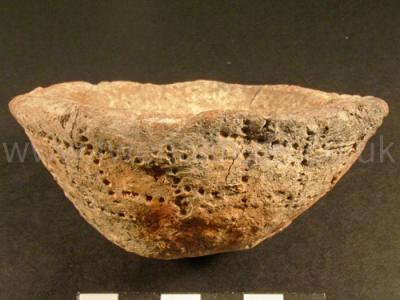
Wiltshire Museum. DZSWS:STHEAD.329. 2 rings of Kimmerage shale found with a primary cremation under an inverted MBA urn in disc barrow Winterbourne Stoke G68 [Map], excavated by William Cunnington.
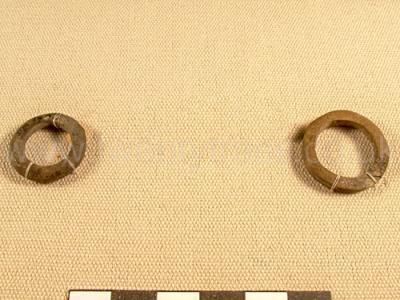
Wiltshire Museum. DZSWS:STHEAD.329a. 4 segmented faience beads found with a primary cremation under an inverted MBA urn in disc barrow Winterbourne Stoke G68 [Map], excavated by William Cunnington.
